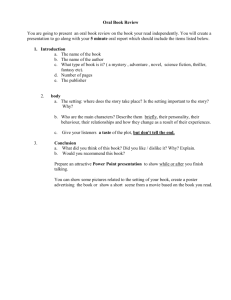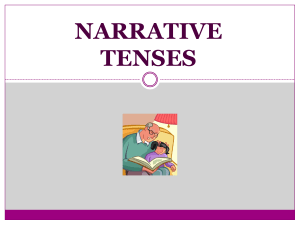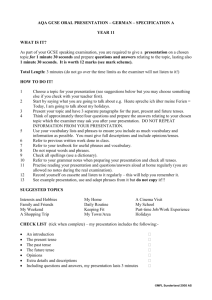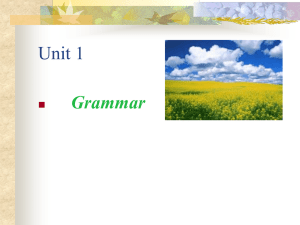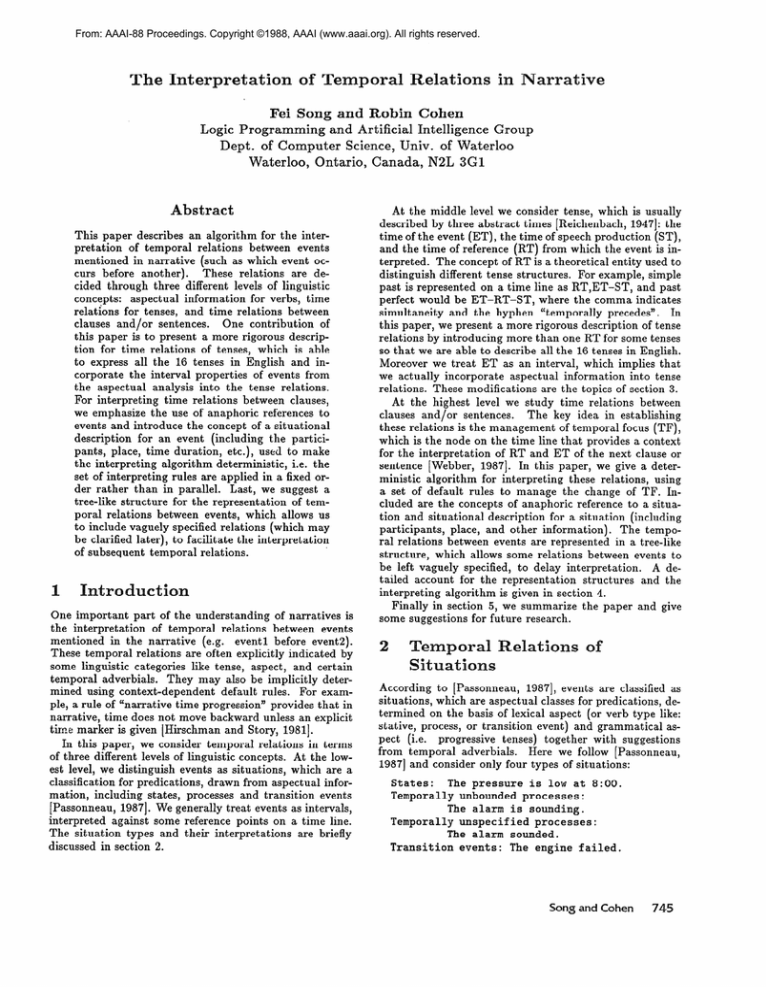
From: AAAI-88 Proceedings. Copyright ©1988, AAAI (www.aaai.org). All rights reserved.
The Interpretation
of Temporal
Rdations
in Narrative
Fei Song and Robin Cohen
Logic Programming
and Artificial Intelligence
Group
Dept. of Computer
Science, Univ. of Waterloo
Waterloo,
Ontario, Canada, N2L 3Gl
Abstract
This paper describes
an algorithm
for the interpretation
of temporal
relations
between
events
mentioned
in narrative
(such as which event ocThese relations
are decurs before another).
cided through three different levels of linguistic
concepts:
aspectual
information
for verbs, time
relations for tenses, and time relations
between
One contribution
of
clauses and/or
sentences.
this paper is to present a more rigorous description for time relations
of tenses, which is able
to express all the 16 tenses in English and incorporate
the interval properties
of events from
the aspectual
analysis into the tense relations.
For interpreting
time relations
between clauses,
we emphasize
the use of anaphoric
references to
events and introduce the concept of a situational
description
for an event (including
the participants, place, time duration,
etc.), used to make
the interpreting
algorithm
deterministic,
i.e. the
set of interpreting
rules are applied in a fixed order rather than in parallel.
Last, we suggest a
tree-like structure for the representation
of temporal relations
between events, which allows us
to include vaguely specified relations (which may
be clarified later), to facilitate the interpretation
of subsequent
temporal relations.
One important
part of the understanding
of narratives is
the interpretation
of temporal
relations
between
events
mentioned
in the narrative
(e.g.
event1 before event2).
These temporal
relations are often explicitly
indicated
by
some linguistic
categories
like tense, aspect, and certain
temporal
adverbials.
They may also be implicitly
determined using context-dependent
default rules.
For example, a rule of %mrrative time progression”
provides that in
narrative, time does not move backward unless an explicit
time marker is given [Hirschman
and Story, 19811.
In this paper, we consider temporal
relations in terms
of three different levels of linguistic concepts.
At the lowest level, we distinguish
events as situations,
which are a
classification
for predications,
drawn from aspectual information, including
states, processes
and transition
events
[Passonneau,
19871. We generally treat events as intervals,
interpreted
against some reference points on a time line.
The situation
types and their interpretations
are briefly
discussed in section 2.
At the middle level we consider tense, which is usually
described by three abstract times [Reichenbach,
19471: the
time of the event (ET), the time of speech production
(ST),
and the time of reference (RT) from which the event is interpreted.
The concept of RT is a theoretical entity used to
distinguish
different tense structures.
For example, simple
past is represented
on a time line as RT,ET-ST,
and past
perfect would be ET-RT-ST,
where the comma indicates
simultaneity
and the hyphen
“temporally
precedes”.
In
this paper, we present a more rigorous description
of tense
relations by introducing
more than one RT for some tenses
so that we are able to describe all the 16 tenses in English.
Moreover we treat ET as an interval, which implies that
we actually incorporate
aspectual
information
into tense
relations.
These modifications
are the topics of section 3.
At the highest level we study time relations
between
clauses and/or
sentences.
The key idea in establishing
these relations is the management
of temporal focus (TF),
which is the node on the time line that provides a context
for the interpretation
of RT and ET of the next clause or
sentence [Webber,
19871. In this paper, we give a deterministic
algorithm
for interpreting
these relations,
using
a set of default rules to manage the change of TF. Included are the concepts
of anaphoric
reference to a situation and situational
description
for a situation
(including
participants,
place, and other information).
The temporal relations between events are represented
in a tree-like
structure,
which allows some relations
between events to
be left vaguely specified,
to delay interpretation.
A detailed account for the representation
structures
and the
interpreting
algorithm is given in section 4.
Finally in section 5, we summarize
the paper and give
some suggestions
for future research.
elations
of
Situations
According
to [Passonneau,
19871, events are classified as
situations,
which are aspectual classes for predications,
determined on the basis of lexical aspect (or verb type like:
stative, process, or transition
event) and grammatical
aspect (i.e.
progressive
tenses) together
with suggestions
from temporal
adverbials.
Here we follow [Passonneau,
19871 and consider only four types of situations:
States:
The pressure
is low at 8:O0.
Temporally
unbounded
processes:
The alarm is sounding.
Temporally
unspecified
processes:
The alarm
sounded.
Transition
events:
The engine
failed.
Song and Cohen
745
A detailed account on the distinction
between these four
types of situations
is presented in [Passonneau,
19871. In
this paper, we generally treat events as intervals’ and interpret these intervals against some reference points, sometimes explicitly mentioned,
as 8:00 in the example for state.
One difference from Passonneau
is that we add a default
rule for the interpretation
of a temporally
unspecified
process, i.e. we interpret the associated
interval for the event
time against some reference point which coincides with the
start point of the interval.
Later on, we can modify the
interpretation
if the speaker uses a progressive verb or certain temporal adverbial to indicate that the reference point
should lie within the interval.
3
Temporal
Relations
(Mary said
Aconcagua.
that)
John
would
climb
since the situation
UJohn’s climbing Aconcagua”
is talked
about at RT’ before ST, and the situation happens at RT
after RT’.
Our description
for tenses in the Appendix
also includes
aspectual information
for situations.
This can be seen from
the comparisons
between simple and progressive,
perfect
and perfect progressive
tenses.
The progressive
and perfect progressive
are used for non-stative
verbs and suggest
temporally
unbounded
processes.
The simple and perfect
may suggest states or temporally
unspecified
processes
or
transition events, depending
on the verb types.
Most of the time relations
listed in the Appendix
are
uniquely determined
except past future tenses (marked by
‘Classifying
events as situations provides additional information (e.g. boundedness properties) for the interpretation of
temporal relations between events. The time points associated
with transition events can be considered as reduced intervals.
2See the Appendix.
The 7 tenses in Reichenbach’s description are marked by +.
3The event “Mary said that” is used to provide a context
such. that the following event “John’s climbing Aconcagua” is
explained in past future tenses rather than in modal uses.
746
Natural Language
Before(RT’
, RT)
and
(Before(RT,
ST)
or Before(ST,
and
Before
CRT’ , ST)
or Equal(RT,
RT)
ST)
1;
of ‘Tenses
Most of the work on time relations of tenses [Reichenbach,
1947; Webber,
1987; Passonneau,
19871 is based on Reichenbach’s
notions of three times: speech time(ST),
event
time(ET) , and reference time(RT).
By considering
all of
the possible permutations
of these three times, we can see
that they only denote 13 different temporal configurations
on a time line, corresponding
to 7 tenses in English [Reichenbach,
19471. However there are actually 16 tenses in
English2.
In this section, we present a more rigorous description
for tenses, which is able to specify all the 16 tenses, by
introducing
more than one RT. In fact, we even view ST
as a kind of reference time to the time when a narrative is
given. But ST is more important
than other RT’s in that it
determines the use of tenses for a clause or sentence. There
is also one RT which is more important
than other RT’s.
This RT is the reference point for interpreting
the interval
ET. Besides ST and RT, there may be other RT’s for some
tenses, denoted as RT’, RT”. For example,
a sentence in
the past future (see (4) in the Appendix)
will need two
RT’s3 :
(3.1)
*), which correspond
to multiple cases. The partial restrictions on times of these tenses can be treated more rigorously in terms of Allen’s logic [Allen, 19811. For example,
the past future tense (4) and past future progressive
(8)
can be expressed as:
Figure
1.
These tense relations, which correspond
to multiple cases,
are usually decided in the context of narrative when the
relations between the current ET and ST can be decided
(see section 4).
4
Temporal
Narrative
elations
of
In this section, we discuss the temporal relations between
clauses and/or sentences in narrative.
First in section 4.1,
we suggest a tree-like structure for representing
these relations, and consider the contribution
of various kinds of
linguistic expressions
through examples.
Then in section
4.2, we present a deterministic
algorithm
for interpreting
these relations by using the concepts of temporal focus and
its default management
rules. Last, we show the use of the
algorithm through several example narratives.
4.1
epsesentation
Relations
The temporal relations
in Allen’s logic [Allen,
itive relations:
(1) Before(i1,
(21
(3)
(4)
(5)
of TemporalI
between intervals can be described
19811, in which there are five prim-
i2)
--before
i2,
and they
Meets (il , i2)
--i2,
but there
is no
During(i1,
i2)
--contained
with i2.
Equal (il , i2)
--are the same.
Overlap(i1,
i2> --before
i2,
and they
Time interval
il is
do not overlap.
Interval
il is before
interval
between
them.
Interval
il is fully
Intervals
il
and
i2
Interval
il starts
are overlapped.
are maintained
in a network where the
These relations
nodes represent individual intervals and the labels on arcs
indicate the relations between nodes in the network. However we feel they are too primitive
for a representation
of a narrative since the relations suggested in English are
usually quite vague. For example,
by analyzing the tense
relations for two sentences, we may decide that ET1 happens at a earlier time than ET2, but we cannot say whether
ET1 UBefore” or QMeets” or UOverlap” with ET2. In most
cases, only partial restrictions
on temporal
relations
between situations
can be obtained
from a narrative
at a
time.
If we try to consider
all of the possible
cases in
terms of the five primitives
and the inverses of them, we
have to make a lot of inferences.
Although
%eference intervals” are used in [Allen, 19811 to reduce the possible
inferences on temporal relations, there are still quite a few
inferences to be made between the intervals with the same
reference interval.
We instead classify the five primitives
into two categories
and introduce
two high-level relations:
QPrecedes” and “Includes”
for them. They are defined as
follows:
Precedes
(ii,
Meets(i.1,
Includes(i1,
Equal (ii,
= Before(i1,
i2)
i2)
or Overlap(i1,
i2)
= During(i1,
i2) ;
i2)
or
i2);
i2)
or
We then propose a processing strategy whereby the vaguer
relations may be replaced by one of the five primitives,
as
more information
about the relation between the events is
presented.
These two high-level relations
can be used to organize
the representation
network into a tree-like structure.
UIneludes” is used to represent temporal
relations between a
father and its sons, while “Precedes”
represents temporal
relations between the brothers.
In this way, we can clearly
represent the fact that the property P held by a father can
be inherited by the sons. For example, the temporal
con-figuration of intervals in Figure 2 can be represented
as a
tree-like structure
at the bottom.
Figure 2.
Representation
of
"Includes"
and "Precedes"
where the horizontal
links can be labeled by “b” or “m”
or cc~” if they can be decided as QBefore” or UMeets” or
UOverlap” relations.
Similarly, the vertical links can be labeled by “d” or ‘e” depending on the UDuring” or “Equal”
relations.
There may be cases where the relations
between some
intervals cannot be decided
in terms of UPrecedes” and
UPrecedes or the inverse of
UIncludes” themselves,
e.g.
Precedes”
and QPrecedes or Includes”,
etc. However we
believe in narrative,
these intervals are usually partially
related to some intervals in terms of UPrecedes” and “Ineludes”,
otherwise
the narrative
is probably
incoherent.
These cases can be represented
in our notation
by only
specifying the partial relations as different branches, leaving the undecided
relations unspecified.
For example, the
relations of past future tenses (4) and (8) in the Appendix
can be represented
as follows:
HRT
RT’
AT
Figure
3.
Representation
tenses
(4) and (8)
of
where the relations between ST and RT cannot be decided
by tense relations, but the partial relations:
“Before(RT’,
specified.
When,
“Before(RT’,
RT)” are explicitly
ST)“,
some time later, the relations
between
intervals and/or
points in the two branches
are suggested,
we can make
inferences
to decide them in terms of the five primitive
and two high-level relations.
For example, in tense (4)’ if
the following situation is given after RT and expressed in
the past tense, then we can decide “Before(RT,
ST)“. We
believe that this vague representation
facilitates
the interpretation of temporal relations in narrative, by postponing
some decisions.
The linguistic
expressions
for temporal
relations
come
from various sources in narrative.
They may be: (1) situation types, (2) tense relations,
(3) context information,
such as references
and default rules, (4) temporal
adverbials and (5) spatial information.
Most of these have been
discussed
in the previous sections;
here, we only explain
the use of anaphoric references to events and spatial information in detail.
Anaphoric
references to events are important
since they
can add more temporal information.
For instance, in (4.1):
(4.1)
John
once
has been to California
(~~11.
It was in 1986.
the %” refers to the situation
‘John’s
being in California” and explicitly
provides the time location
“in 1986”“.
These references usually take the forms of Prosentential,
Pro-verbs,
Proactions,
etc.
mentioned
in [Hirst, 1981).
They only provide more information
about already mentioned events so that their relations to other intervals can
be determined
more clearly.
Spatial information
can be distinguished
into two sorts,
the first of which is spatial relations between events. For
instance, in (4.2):
(4.2)
John went over to Mary’s
house
(ETl)
On the way, he had stopped
by the
flower
shop for
some roses
(ET2).
.
the adverbial
Uon the way” indicates
that the situation
ET2 should appear within ET1 U John’s going over to
Mary’s house”.
Thus this sort of spatial information
can
also contribute
to the determination
of temporal relations
between intervals.
The other sort is the situational
description
for a event,
which basically
consists of participants,
place, and time
duration for the event.
Its use can be illustrated
by the
following narrative example from [Webber,
19871:
(4.3)
a.
b.
c.
I was at Mary’s
house
yesterday
(~~11.
We talked
about
her brother
(ET2).
He spent
5 weeks in Alaska
with
two friends
(ET3) .
Song and Cohen
747
d.
e.
Together,
they made a successful
assault
on Denali
(ET4).
Mary was very proud of him (ET5).
ET1
ET3
/\
ET2
ET4
ET6
In this example,
the first sentence has the situational
description:
(I, Mary, Mary’s house), which is inherited by
uwe” refer to ‘I
the second sentence, since the participants
and Mary,, , so sentence b) can be interpreted
against RTl
of sentence a). Strictly, sentence c) should be expressed in
the past perfect tense, since RT3 for ET3 should be before
RTZ, which is after RTl by default.
Unfortunately,
such
uses are allowed in English and we have to detect them
for the past perfect use. This difference can be captured
in the situational
description
for the sentence c): (He, two
friends, Alaska), which is quite different from sentences a)
and b)‘s.
This indicates that ET3 cannot be interpreted
against RT2, but at some point RT3 before RT2. Similarly,
in sentence e), the participant
goes back to Mary, which
implies that we should interpret ET5 against RT2, since its
situational
description
includes the participant
Mary.
In
conclusion,
the situational
descriptions
can provide more
information
for us to check the inconsistency
of default
interpretations
based on tenses (see section 4.2).
4.2
Interpretation
Relations
ET1
I
TF
ST
I
t
In this subsection,
we try to solve the second problem by
treating
ET as an interval and describing
the tense relations for each kind of situation
(see the Appendix).
Because in our approach
some tenses may have more than
one RT’s, we will modify Webber’s
definition of TF as: at
any point N in the narrative,
TF is the node on the time
line that provides
a context for the interpretation
of the
RT’s of the next clause. Usually it is the RT which is referred to the current TF, but a new TF has to be created
when the RT, against which the next ET is interpreted,
is
not the same as the current TF.
Next we produce a deterministic
algorithm by using the
concepts
of anaphoric
references
to situations
and situa-
748
Natural Language
Algorithm
Input: a set of ET’s from clauses in narrative,
their situation types and tense relations
RT’s (see section 2 and 3).
Output:
poral
a tree-like structure,
showing
relations between the ET’s.
including
with ST and
the partial
tem-
(1) set TF to ST.
while
InputSet
# empty
do
begin
Input
a new situation
ETi.
(2) If there is an anaphoric reference to some previous ET,
find in the stack a RT against which ET is interpreted.
If found, consider
RT as TF and pop the elements
above RT4.
(3) Check
of Temporal
The key idea in interpreting
temporal
relations in narrative is the temporal
focus or TF. In [Webber,
19871, it
is maintained
by four management
heuristics:
a Maintenance Heuristic, two Embedded
Heuristics, and a Resumption Heuristic.
However these heuristics are assumed to be
used in parallel since there is no simple way to fix the order. Another problem in [Webber,
19871 is that aspectual
information
is not incorporated
in the interpretation,
and
ET is treated as a time point. As a result, QIncludes” relations between events cannot be represented
exactly on the
the temporal relation in example
time line. For instance,
4.2 is interpreted
as ET2 ‘Precedes”
ETl, shown in the
Figure 4:
ET2
1
tional descriptions.
The former provides
an explicit way
to return to a previously
mentioned
situation and thus we
assign it the highest priority in the algorithm
(see (2) below). The latter may suggest an implicit way to change the
TF, either return to a previous situation, or establish a new
TF. These two concepts,
together with tense relations and
situation
types, lead us to the following
algorithm.
Like
other focusing processes,
we also employ a stack to hold
the previous
TF’s, where the top of the stack holds the
most recent TF and the stack is searched top-down.
RTi
against
TF.
i) If the relation between ST and RTi doesn’t match
the one between ST and TF, then create a new
TF for RTi of ETi and push the current TF onto
the stack.
ii) If ETi is
scription
the stack
tion with
pop the
new TF
use) and
in the past tense and its situational
deis inconsistent
with TF’s, then find in
a RT which has a consistent
descripETi’s.
If found, resume RT as TF and
elements above RT, otherwise
create a
before the current TF (for past perfect
push the current TF onto the stack5.
(4) Check the relation between ETi and the ET associated with the current TF, (which is the TF on the top
of the stack when a new TF is created in the above
steps.).
If “Includes”
or “Precedes”
is suggested explicitly by some adverbials
or implicitly
by relations
between situation types, then do the following:
i) If a new TF has not been created, create a new
TF and push the current TF onto the stack.
ii) Put the new TF inside the interval of ET for Yneludes” and before or after ET for ‘Precedes”.
(5) Interpret ETi against TF. Moreover,
if ETi is a temporally unspecified process, shift TF to the end of ETi.
end
This algorithm
is deterministic
since for each input, we
will apply the defaults in a fixed order and it will terminate
41f not found, interrupt the algorithm and suggest an message of incoherence to the user.
51n this algorithm, the TF change caused by the inconsistency with descriptions is limited to past tense. The change for
other tenses will be left for future work.
when all inputs are processed.
above algorithm by the following
(4.4)
Now let’s illustrate
the
examples [Webber, 19871.
John went over to Mary’s
touse
(~~11.
by the
On the way, he had stopped
flower
shop for
some roses
(ET2).
Unfortunately,
the roses
failed
to cheer
her up (ET3).
a.
b.
c.
a
ST
ET1
(b)
’
TFl
RTl
I
TFl ’
=~I1 ET1
TFl
RTl
TF2
RT2
TF3’
TF2’
RT3,TF3
Figure
TFI’
ST
I
TF
t-
6.
Another example (4.3) h as b een discussed at the end of section 4.1, in which the interpretation
of sentence 3) needs
to create
a new TF before the current TF2’.
Also since
the situational
description
of ET3 is inconsistent
with the
ETl’s,
ET3 should be located before ETIG.
The examples in this section serve to illustrate the proposed algorithm.
Introducing
the particular
tree-like representation
of section 4.1 facilitates
discussion
of the alFor simplicity,
we have omitted
gorithm and examples.
some details, for example, the power of our chosen representation is a topic for future work. Unspecified
relations
between ET’s are assumed to undergo a subsequent
inferencing procedure,
to deepen the representation.
TF
(a)
bin ET1 rl’*~
Dir)
011
ST
TF W
ST
TF
ST
TFl
RTl
TF2
RT2
TF2’RTy1T’F3TF3’
*
Figure
mmaries
”
6.
When
At, the beginning,
TF = ST (see Figure 5(a)).
the first sentence is interpreted,
RTl refers to some node
before ST, thus a new TFl before ST is created (step(3)
i)). Since ET1 is a temporally
unspecified
process, we by
default (step (5)) interpret it against TFl and shift TFl to
the end point of ET1 as TFl’ after the interpretation
(see
Figure 5(b)).
S ince the second sentence is in the past perfect, tense, it has two reference times: RT2’ and RT2. RT2’
can be referred to TFl’, but RT2 must be referred to some
time point before TFl’.
Again a new TF2 before TFl’ has
to be created (step (3) i)). By the spatial adverbial
“on
the way,,, we can decide that TF2 falls within ETl, thus
we interpret RT2 and ET2 there, and then shift TF2 to the
end of ET2 as TF2’ for the next sentence (see Figure 5(c)).
Now for the third sentence, the current TF is TF2’, and the
situational description
for ET1 and ET2 are : (John, Mary,
Mary’s house) and (John, flower shop) respectively.
Since
the third sentence is in the past tense, there is only one
RT which may be interpreted
against TF. However by (3)
description
for ET3 is: (Mary),
ii) above, the situational
which is inconsistent
with TF’s: (John, flower shop). Thus
we have to check it with TF’s in the stack. Because ETl’s
situational
description
includes Mary, ET3 can be interpreted against TFl’,
as shown in Figure 5(d).
In the example 4.5, the first two sentences
as in 4.4, but the third sentence is changed.
(4.5)
are the same
a-b.
are the same as in (4.4)
c. He picked
out 5 red ones,
3 white
ones and one pale
pink
(ET3).
This time since the situational
description
for ET3:
is consistent with ET2’s, so ET3 can be interpreted
TF2’ as in Figure 6.
(John)
against
and Suggestions
Our deterministic
algorithm for interpreting
temporal relations in narrative has been described through three levels
of linguistic concepts:
situation types, tense relations, and
time relations between clauses and/or sentences in narrative.
In the lowest situation-level,
we generally treat an event
as an interval and interpret the interval against some reference point.
In the middle tense-level, we present a more rigorous description by introducing
more than one RT for some tenses
such that we are able to express all 16 tenses in English
and incorporate
aspectual
information
in the description.
In the highest discourse-level,
we introduce
two highlevel relations:
uPrecedes” and uIncludes” besides the five
primitive
ones[ Allen,
19811.
These relations
are represented in a tree-like structure
such that some vague relations in the processing
of a narrative
can be specified
by “Precedes,,
or ‘Ylncludes” or even partially unconnected
branches.
Later they can be replaced by some primitive
relations when further information
is suggested explicitly
or implicitly in the narrative.
Finally we present an deterministic interpreting
algorithm based on all possible movements of temporal focus (TF). In particular, we emphasize
the anaphoric
reference to a situation
as an explicit way,
and the concept of situational
description
(including
participants, place, tan ime duration, etc.) as implicit way to
change TF.
Our work in this paper is mainly on narrative, but most
of the discussions,
we believe, are applicable to other types
of discourse such as goal-oriented
ones. From the standpoint of temporal relations,
“generation”
relation between
actions [Grosz and Sidner, 1986; Pollack, 19861 is also an
Yncludes”
relation since the time used in the execution of
a subaction
is only a part of the time used for the whole
‘In these examples, we use time line structures
to clearly
show the change of TF. They can be easily transformed into
tree-like structures.
Song and Cohen
749
However the relations
between subacgenerated
action.
tions are not always UPrecedes” because some subactions
may be executed in parallel, while others in sequence.
In
general, we have to use more than one level of temporal
relations to characterize
these relations.
How “generation”
relation affects the temporal relations and vice versa is certainly an interesting
topic for future research.
Other remaining
problems
include the investigation
of
the interaction
between temporal interpretation
and reference resolution,
and the incorporation
of duration
information in our representation.
In conclusion,
we feel that our approach provides a richer
representation
for the temporal relations in narrative.
A
The Temporal
elatisns
of 1
!Ik?nses
(1) Simple Present+:
ST = RT, (RT = ET (event) or
RT in ET (stative
or process)),
e.g.
John climbs
Aconcagua.
(2)
Simple Past+:
ST > RT, (RT = ET (event) or
RT in ET (stative or process)),
e.g.
John climbed
Aconcagua.
(3)
Simple Future+:
RT in ET (stative
Aconcagua.
(4)
Past Future +*:
ST > RT’, RT’ < RT, (RT =
ET(event)
or RT in ET(stative
or process)),
e.g. John
would climb Aconcagua.
(5)
Present
stative),
ST < RT, (RT = ET (event) or
or process)),
e.g. John will climb
Progressive:
ST = RT, RT in ET
e.g. John is climbing Aconcagua.
(non-
(6) Past Progressive:
ST > RT, RT in ET (non-stative),
e.g. John was climbing Aconcagua.
(7) Future Progressive:
ST < RT, RT in ET (non-stative),
e.g. John will be climbing Aconcagua.
(8)
Past Future Progressive*:
ST > RT’, RT’ < RT,
RT in ET (non-stative),
e.g. John would be climbing Aconcagua.
(9) Present Perfect+:
ST = RT’, RT’ > RT,
(event) or RT in ET (stative or process)),
has climbed Aconcagua.
(RT = ET
e.g. John
(10) Past Perfect+:
ST > RT’ > RT, (RT = ET (event) or
RT in ET (stative or process)),
e.g. John had climbed
Aconcagua.
(11) Future Perfect+:
ST < RT < RT’, (RT = ET (event)
or RT in ET (stative or process)),
e.g. John will have
climbed Aconcagua.
(12)
Past Future Perfect*:
ST > RT’,RT’
< RT <
RT”,(RT=ET
( event) or RT in ET (stative or process)), e.g. John would have climbed Aconcagua.
(13) Present Perfect, Progressive:
RT in ET (non-stative),
e.g.
Aconcagua.
(14)
750
Past Perfect
Progressive:
in ET (non-stative),
e.g.
Aconcagua.
Natural Language
ST = RT’, RT’ > RT,
John has been climbing
ST
John
> RT’ > RT, RT
had been climbing
(15) Future Perfect
ET (non-stative),
Aconcagua.
Progressive:
ST < RT < RT’, RT in
e.g. John will have been climbing
(16) Past Future Perfect Progressive*:
RT < RT”, RT in ET (non-stative),
have been climbing Aconcagua.
ST > RT’, RT’ <
e.g. John would
Note that in many English grammar
books,
the past
forms of future tenses are not listed, but they, like other
tenses,
have their required
verb forms and are better
treated as past, future tenses.
[Allen, 19811
tation of
8j, pages
Artificial
James F. Allen. An interval-based
represenIJCAItemporal knowledge.
In Proceedings
221-226, International
Joint Committee
for
Intelligence,
1981.
Gross and Sidner, 19861 Barbara
J. Grosz
and
Candate
L. Sidner.
Attention,
intentions,
and the
Computational
Linguistics,
structure
of discourse.
12(3):175-204,
1986.
Hirschman
and Story, 19811 Lynette Hirschman and Guy
Story.
Representing
implicit
and explicit
time relations
in narrative.
In Proceedings
IJCAI- 81 9
pages 289-295,
1981.
[Hirst, 19811 Graeme
Hirst.
Anaphora
in Natural Language Understanding:
A Survey. Spring-Verlag,
1981.
[Passonneau,
19871 Rebecca
J. Passonneau.
Situations
and intervals.
In Proceedings
,%th-ACL
Conference,
pages 16-24, Association
for Computational
Linguistics, 1987.
[Pollack, 19861 Martha
E. Pollack.
Plans in Question-Answering.
SRI International,
1986.
Inferring
Domain
Technical
Note 403,
[Reichenbach,
19471 H ans Reichenbach.
Elements of Symbolic Logic, pages 287-299.
The Free Press, New York,
1947.
[Webber,
19871 Bonnie Lynn Webber.
The interpretation
of tense in discourse.
In Proceedings
25th-ACL
Con1987.
ference, pages 147-154,

